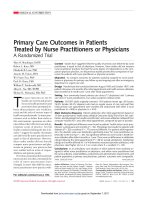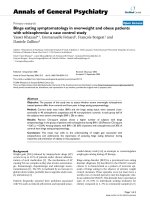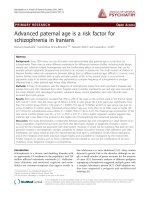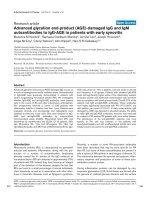Báo cáo y học: "Advanced glycation endproducts in sepsis and mechanical ventilation: extra or leading man" docx
Bạn đang xem bản rút gọn của tài liệu. Xem và tải ngay bản đầy đủ của tài liệu tại đây (44.16 KB, 2 trang )
Available online />Page 1 of 2
(page number not for citation purposes)
Abstract
Advanced glycation endproducts (AGEs) are primarily known as a
complication in diabetic patients through their mediation of the
inflammatory response. However, a variety of studies have
demonstrated enhanced formation of AGEs in cardiovascular
disorders. Despite the large number of AGEs produced during the
Maillard reaction, recent focus is on the major non-crosslinking
AGE N
ε
-carboxymethyllysine. Kneyber and colleagues focused on
sepsis-induced cardiac dysfunction and investigated whether
myocardial inflammation is associated with enhanced cardiac AGE
deposition and whether this is further enhanced by mechanical
ventilation. They showed that both conditions are associated with
enhanced AGE deposition and myocardial inflammation. Therefore,
AGEs may participate in the inflammatory response related to
cardiac dysfunction in critically ill patients. Moreover, life-saving
ventilation stimulates AGE formation in these patients. This
interesting study raises the question of whether AGEs in critically ill
patients are a driving force of the disease.
Advanced glycation endproducts
The advanced glycation endproduct (AGE) N
ε
-carboxy-
methyllysine (CML), as recently investigated by Kneyber and
colleagues [1], can be formed either from glucose via
ketoamine or glyoxal or from lipids by oxidation via glyoxal.
This may explain why the pathophysiological role of AGEs is
not restricted to diabetes, in which condition they have been
primarily studied [2].
The enhanced formation of AGEs results in enhanced urinary
excretion. In this context, renal-insufficient patients have been
associated with CML values several times higher than in
healthy controls. Accumulating AGEs can be observed
histologically as endothelial depositions in atherosclerotic
plaques and tubular cells [3-5]. Their deposition initiates
increased NADPH oxidase and nuclear factor κB activity as
well as a reduction in endothelial nitric oxide synthase activity
[6]. These major effects cause inflammatory changes,
extracellular matrix accumulation and endothelial dysfunction.
Therefore, AGE accumulation is a potential target for treating
inflammatory diseases.
AGEs in sepsis and during mechanical
ventilation
The new and interesting idea of Kneyber and colleagues was
to investigate the association of CML with myocardial
inflammation during sepsis and the clinically relevant state of
mechanical ventilation, which by itself is known to induce AGE
accumulation in the lungs. This is of relevance as sepsis-
induced cardiac dysfunction is a frequent complication
associated with increased mortality. Therefore, they focused on
a situation where AGE accumulation is increased by systemic
inflammation and exacerbated by mechanical ventilation. The
association of CML with myocardial inflammation in sepsis and
mechanical ventilation is intriguing. Indeed, sepsis enhances
CML deposition, which is further aggravated by mechanical
ventilation. Thus, the myocardial deposition of AGEs is
associated with the disease and the therapeutic approach of
mechanical ventilation perpetuates AGE formation.
Opposing AGE effects in cardiovascular
animal models
These results raise the question, however, whether the
association reflects a relevant pathophysiological mechanism
or ‘only’ reflects the critical disease state. In the former case,
interfering with the production or accumulation of AGEs
could provide possible treatments. One option is to
administer soluble RAGE - the extracellular ligand-binding
domain of RAGE, the AGE receptor - which binds AGEs and
thereby limits the deleterious effects of AGEs. In animal
experiments, treatment with soluble RAGE ameliorated
inflammation and significantly reduced the atherosclerotic
lesion area in a glycemia- and lipid-independent manner [7].
Commentary
Advanced glycation endproducts in sepsis and mechanical
ventilation: extra or leading man?
Marcus Baumann
Department of Nephrology, Klinikum rechts der Isar, Technical University Munich, Ismaninger Str. 22, 81675 Munich, Germany
Corresponding author: Marcus Baumann,
Published: 14 July 2009 Critical Care 2009, 13:164 (doi:10.1186/cc7939)
This article is online at />© 2009 BioMed Central Ltd
See related research by Kneyber et al., />AGE = advanced glycation endproduct; CML = N
ε
-carboxymethyllysine.
Critical Care Vol 13 No 4 Baumann
Page 2 of 2
(page number not for citation purposes)
Another pharmacological option is blockade of AGE forma-
tion by substances such as aminoguanidine or pyridoxamine.
These have also been proven to prevent age-related cardiac
hypertrophy in the absence of changes in collagen and
elastin content [8] and diabetic complications in animal
models [9]. These different approaches to treat AGE accu-
mulation and the pathophysiological relevance of AGE
formation in sepsis and mechanical ventilation need to be
addressed in future studies using either soluble RAGE or
blockers of AGE formation.
AGEs in human cardiovascular disorders
Several cross-sectional studies have documented that AGE-
induced inflammation is also present in human diseases with
chronic low-grade inflammation and has also been associated
with diabetic microangiopathy [10], endothelial dysfunction
[11], atherosclerosis [3] and chronic heart failure [12].
However, in a prospective substudy of the Irbesartan Type 2
Diabetic Nephropathy Trial (IDNT) cohort including 450
patients with nephropathy caused by type 2 diabetes, CML
was not predictive for cardiovascular events [13]. Therefore,
it remains uncertain whether CML is of cardiovascular
relevance in humans.
Conclusions and outlook
Kneyber and colleagues present an interesting association
between a major non-cross-linking AGE and sepsis com-
bined with mechanical ventilation. Whether this association
reflects a pathophysiologically relevant characteristic needs
to be investigated in future studies. However, if interventional
studies demonstrate positive effects in animal models, the
availability of safe and cheap agents may offer an opportunity
to target myocardial inflammation in sepsis and mechanical
ventilation.
Competing interests
The author declares that they have no competing interests.
References
1. Kneyber MCJ, Gazendam RP, Niessen HWM, Kuiper JW, Dos
Santos CC, Slutsky AS, Plotz FB: Mechanical ventilation during
experimental sepsis increases deposition of advanced glyca-
tion end products and myocardial inflammation. Crit Care
2009, 13:R87.
2. Wautier MP, Massin P, Guillausseau PJ, Huijberts M, Levy B,
Boulanger E, Laloi-Michelin M, Wautier JL: N(carboxymethyl)-
lysine as a biomarker for microvascular complications in type
2 diabetic patients. Diabetes Metab 2003, 29:44-52.
3. Baidoshvili A, Niessen HW, Stooker W, Huybregts RA, Hack CE,
Rauwerda JA, Meijer CJ, Eijsman L, van Hinsbergh VW, Schalk-
wijk CG: N(omega)-(carboxymethyl)lysine depositions in
human aortic heart valves: similarities with atherosclerotic
blood vessels. Atherosclerosis 2004, 174:287-292.
4. Baumann M, Caron M, Schmaderer C, Schulte C, Viklicky O, von
Weyhern CW, Lutz J, Heemann U: Renal N(epsilon)-car-
boxymethyllysine deposition after kidney transplantation.
Transplantation 2008, 86:330-335.
5. Baumann M, Stehouwer C, Scheijen J, Heemann U, Struijker
Boudier H, Schalkwijk C: N{epsilon}-carboxymethyl-lysine is
increased in plasma and kidney of spontaneous hypertensive
rats during the early development of hypertension and is
independent of renal function or oxidative stress. Ann N Y
Acad Sci 2008, 1126:201-204.
6. Jandeleit-Dahm K, Cooper ME: The role of AGEs in cardiovas-
cular disease. Curr Pharm Des 2008, 14:979-986.
7. Wendt T, Harja E, Bucciarelli L, Qu W, Lu Y, Rong LL, Jenkins
DG, Stein G, Schmidt AM, Yan SF: RAGE modulates vascular
inflammation and atherosclerosis in a murine model of type 2
diabetes. Atherosclerosis 2006, 185:70-77.
8. Corman B, Duriez M, Poitevin P, Heudes D, Bruneval P, Tedgui A,
Levy BI: Aminoguanidine prevents age-related arterial stiffen-
ing and cardiac hypertrophy. Proc Natl Acad Sci USA 1998,
95:1301-1306.
9. Davis BJ, Forbes JM, Thomas MC, Jerums G, Burns WC, Kawachi
H, Allen TJ, Cooper ME: Superior renoprotective effects of
combination therapy with ACE and AGE inhibition in the dia-
betic spontaneously hypertensive rat. Diabetologia 2004, 47:
89-97.
10. Boehm BO, Schilling S, Rosinger S, Lang GE, Lang GK,
Kientsch-Engel R, Stahl P: Elevated serum levels of N(epsilon)-
carboxymethyl-lysine, an advanced glycation end product, are
associated with proliferative diabetic retinopathy and macular
oedema. Diabetologia 2004, 47:1376-1379.
11. Lieuw AFML, van Hinsbergh VW, Teerlink T, Barto R, Twisk J, Ste-
houwer CD, Schalkwijk CG: Increased levels of N(epsilon)-
(carboxymethyl)lysine and N(epsilon)-(carboxyethyl)lysine in
type 1 diabetic patients with impaired renal function: correla-
tion with markers of endothelial dysfunction. Nephrol Dial
Transplant 2004, 19:631-636.
12. Hartog JW, Voors AA, Schalkwijk CG, Scheijen J, Smilde TD,
Damman K, Bakker SJ, Smit AJ, van Veldhuisen DJ: Clinical and
prognostic value of advanced glycation end-products in
chronic heart failure. Eur Heart J 2007, 28:2879-2885.
13. Busch M, Franke S, Wolf G, Brandstadt A, Ott U, Gerth J, Hun-
sicker LG, Stein G: The advanced glycation end product
N(epsilon)-carboxymethyllysine is not a predictor of cardio-
vascular events and renal outcomes in patients with type 2
diabetic kidney disease and hypertension. Am J Kidney Dis
2006, 48:571-579.









